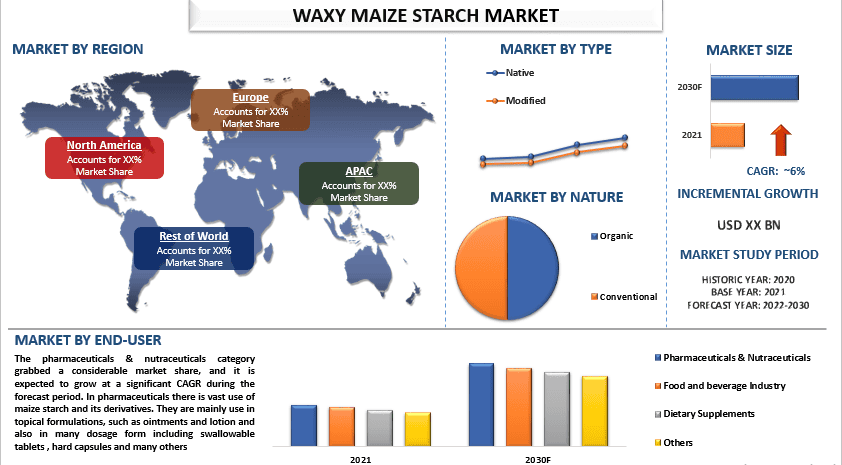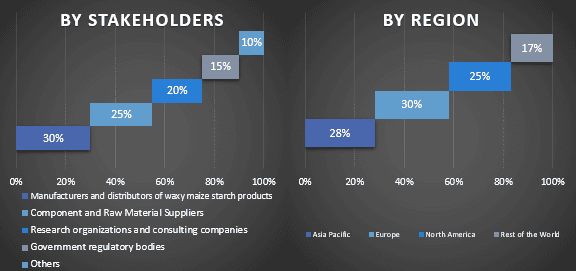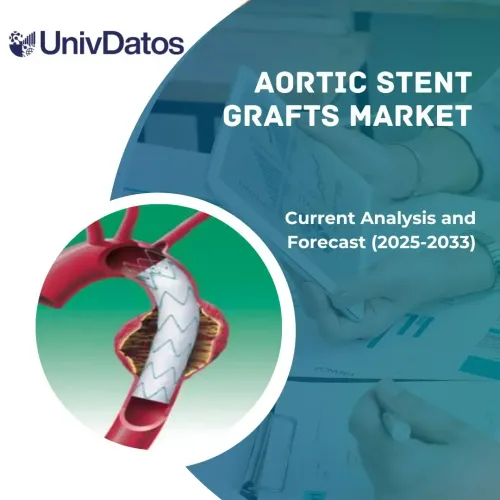- Accueil
- À propos de nous
- Industrie
- Services
- Lecture
- Contactez-nous
Marché de l'amidon de maïs cireux : Analyse actuelle et prévisions (2022-2030)
Accent sur le type (natif, modifié) ; la nature (biologique, conventionnelle) ; l’utilisateur final (industrie agroalimentaire, compléments alimentaires, produits pharmaceutiques et nutraceutiques, autres) ; et la région/le pays

La valeur du marché de l'amidon de maïs cireux était de 3 milliards de dollars US en 2021 et devrait croître à un TCAC de 6 % de 2022 à 2030. L'amidon de maïs cireux est un hydrate de carbone fabriqué à partir de maïs. Son principal constituant est l'amylopectine, une molécule d'hydrate de carbone très ramifiée et complexe. L'amidon de maïs cireux, contrairement aux autres types d'amidon de maïs, contient un niveau élevé d'amylopectine et un faible niveau d'amylose, ce qui le rend moins sujet à la gélatinisation et moins susceptible de former des grumeaux ou des amas dans les préparations alimentaires. L'amidon de maïs cireux est parfait pour être utilisé comme ingrédient épaississant dans les aliments et les boissons, ainsi que dans diverses applications industrielles telles que la fabrication d'adhésifs, de revêtements et de produits en papier. Il est également utilisé dans les compléments de nutrition sportive comme source d'énergie. La demande croissante d'amidon de maïs cireux peut être attribuée à la demande croissante de l'industrie des aliments et des boissons, ce sont les principaux facteurs qui stimulent l'adoption de stratégies de croissance inorganiques parmi les principaux acteurs de l'industrie dans le monde entier. Par exemple, en 2021, AGRANA Beteiligungs-AG a investi 27,36 millions de dollars US dans plusieurs projets au cours de l'exercice financier 2021-22. L'entreprise a augmenté sa capacité de transformation du maïs de spécialité à Aschach, en Autriche. En raison des statistiques flagrantes, l'amidon de maïs cireux est utilisé dans une variété d'applications, telles qu'un agent épaississant dans les soupes et les jus de viande, les garnitures de tartes, les ragoûts et les plats mijotés, et les sauces en raison de sa capacité d'absorption d'eau élevée, ce qui contribuera également à la croissance du marché dans la période à venir. L'amidon de maïs cireux est de plus en plus utilisé comme ingrédient clé dans les produits de nutrition sportive, en particulier dans les boissons et les compléments pour sportifs. L'amidon de maïs cireux est un hydrate de carbone de poids moléculaire élevé qui est facilement digéré et absorbé par l'organisme, fournissant une source d'énergie rapide sans provoquer de pics d'insuline, ce qui en fait une source d'énergie idéale pour les athlètes et les amateurs de fitness. La demande croissante de produits de nutrition sportive, notamment les boissons énergisantes et les compléments alimentaires, stimule la demande d'amidon de maïs cireux sur le marché.
Parmi les principaux acteurs opérant sur le marché, citons AGRANA Beteiligungs-AG, Cargill Incorporated, Daesang Corp, Ingredion, Interstarch Ukraine, Manildra Group, New Zealand Starch Limited, Roquette Frères, Samyang Corporation, Sinofi Ingredients. Plusieurs fusions et acquisitions ainsi que des partenariats ont été entrepris par ces acteurs pour faciliter l'accès des clients à des produits/technologies de pointe et innovants.
Aperçus présentés dans le rapport
« Parmi les types, le segment natif a détenu une part importante du marché en 2021. »
Selon le type, le marché est segmenté en natif et modifié. Parmi ceux-ci, le segment natif a capté une part importante du marché en 2021. La raison en est que le natif est fréquemment utilisé dans les industries d'utilisation finale comme l'alimentation et les boissons, qui comprennent les produits de boulangerie, les soupes et les sauces, les produits carnés transformés, etc. De plus, il est utilisé pour fabriquer des adhésifs d'étiquette et comme épaississant universel pour les peintures.
« Parmi les natures, le segment biologique a détenu le TCAC le plus élevé du marché en 2021. »
Selon la nature, le marché est divisé en biologique et conventionnel. Parmi ceux-ci, le segment biologique devrait croître à un TCAC plus élevé sur le marché. Cela est dû au fait que la qualité du maïs biologique est supérieure à celle du maïs inorganique. La demande des clients pour des produits naturels et de qualité supérieure a également stimulé la croissance du segment de l'amidon biologique.
« La région Asie-Pacifique a dominé le marché de l'amidon de maïs cireux en 2021. »
L'amidon de maïs cireux a gagné en popularité dans la région Asie-Pacifique en raison de divers facteurs. La demande croissante des industries du papier et du textile, car l'amidon de maïs cireux est utilisé comme liant et agent d'enrobage. La sensibilisation et la popularité croissantes des étiquettes propres et des ingrédients naturels, car l'amidon de maïs cireux est un ingrédient naturel qui est utilisé comme épaississant et stabilisateur. La demande croissante de l'industrie des aliments et des boissons est également attribuée à la croissance du marché de l'amidon de maïs cireux. Par exemple, en mars 2020, Cargill a lancé une nouvelle gamme d'amidons à base de maïs cireux pour l'industrie alimentaire. Les amidons sont conçus pour être utilisés dans une gamme de produits alimentaires, notamment les nouilles, les confiseries et les sauces.
Couverture du rapport sur le marché de l'amidon de maïs cireux

Raisons d'acheter ce rapport :
- L'étude comprend une analyse de la taille du marché et des prévisions validées par des experts clés et authentifiés du secteur.
- Le rapport présente un aperçu rapide de la performance globale du secteur en un coup d'œil.
- Le rapport couvre une analyse approfondie des principaux pairs du secteur en mettant l'accent sur les principales données financières de l'entreprise, les portefeuilles de produits, les stratégies d'expansion et les développements récents.
- Examen détaillé des moteurs, des contraintes, des principales tendances et des opportunités qui prévalent dans le secteur.
- L'étude couvre de manière exhaustive le marché à travers différents segments.
- Analyse approfondie du secteur au niveau régional.
Options de personnalisation :
Le marché mondial de l'amidon de maïs cireux peut être davantage personnalisé selon les besoins ou tout autre segment de marché. En outre, UMI comprend que vous pouvez avoir vos propres besoins commerciaux, n'hésitez donc pas à nous contacter pour obtenir un rapport qui répond parfaitement à vos besoins.
Table des matières
Méthodologie de recherche pour l'analyse du marché de l'amidon de maïs cireux (2022-2030)
L'analyse du marché historique, l'estimation du marché actuel et la prévision du marché futur du marché mondial de l'amidon de maïs cireux ont été les trois principales étapes entreprises pour créer et analyser l'adoption de l'amidon de maïs cireux dans les principales régions du monde. Une recherche secondaire exhaustive a été menée pour collecter les chiffres du marché historique et estimer la taille actuelle du marché. Deuxièmement, pour valider ces informations, de nombreuses conclusions et hypothèses ont été prises en considération. De plus, des entretiens primaires exhaustifs ont également été menés avec des experts de l'industrie à travers la chaîne de valeur du marché mondial de l'amidon de maïs cireux. Après l'hypothèse et la validation des chiffres du marché par le biais d'entretiens primaires, nous avons employé une approche descendante/ascendante pour prévoir la taille complète du marché. Par la suite, des méthodes de ventilation du marché et de triangulation des données ont été adoptées pour estimer et analyser la taille du marché des segments et sous-segments de l'industrie concernée. La méthodologie détaillée est expliquée ci-dessous :
Analyse de la taille du marché historique
Étape 1 : Étude approfondie des sources secondaires :
Une étude secondaire détaillée a été menée pour obtenir la taille du marché historique du marché de l'amidon de maïs cireux à travers des sources internes à l'entreprise telles que les rapports annuels et états financiers, présentations de performance, communiqués de presse, etc., et des sources externes, notamment les journaux, les actualités et articles, les publications gouvernementales, les publications des concurrents, les rapports sectoriels, les bases de données tierces et autres publications crédibles.
Étape 2 : Segmentation du marché :
Après avoir obtenu la taille du marché historique du marché de l'amidon de maïs cireux, nous avons mené une analyse secondaire détaillée pour recueillir des informations sur le marché historique et les parts pour différents segments et sous-segments pour les principales régions. Les principaux segments inclus dans le rapport sont le type, la nature et l'utilisateur final. D'autres analyses au niveau des pays ont été menées pour évaluer l'adoption globale des modèles de test dans cette région.
Étape 3 : Analyse des facteurs :
Après avoir acquis la taille du marché historique des différents segments et sous-segments, nous avons mené une analyse des facteurs détaillée pour estimer la taille actuelle du marché de l'amidon de maïs cireux. De plus, nous avons mené une analyse des facteurs en utilisant des variables dépendantes et indépendantes telles que le type, la nature et l'utilisateur final du marché de l'amidon de maïs cireux. Une analyse approfondie a été menée pour les scénarios de l'offre et de la demande en tenant compte des principaux partenariats, fusions et acquisitions, de l'expansion des activités et des lancements de produits dans le secteur du marché de l'amidon de maïs cireux à travers le monde.
Estimation et prévision de la taille actuelle du marché
Dimensionnement actuel du marché : sur la base des informations exploitables tirées des 3 étapes ci-dessus, nous sommes arrivés à la taille actuelle du marché, aux principaux acteurs du marché mondial de l'amidon de maïs cireux et aux parts de marché des segments. Toutes les parts de pourcentage requises et les ventilations du marché ont été déterminées à l'aide de l'approche secondaire susmentionnée et ont été vérifiées par des entretiens primaires.
Estimation et prévision : pour l'estimation et la prévision du marché, des pondérations ont été attribuées à différents facteurs, notamment les moteurs et les tendances, les contraintes et les opportunités disponibles pour les parties prenantes. Après avoir analysé ces facteurs, les techniques de prévision pertinentes, c'est-à-dire l'approche descendante/ascendante, ont été appliquées pour arriver à la prévision du marché pour 2030 pour différents segments et sous-segments à travers les principaux marchés mondiaux. La méthodologie de recherche adoptée pour estimer la taille du marché comprend :
- La taille du marché de l'industrie, en termes de revenus (USD) et le taux d'adoption du marché de l'amidon de maïs cireux à travers les principaux marchés nationaux
- Toutes les parts de pourcentage, les divisions et les ventilations des segments et sous-segments de marché
- Les principaux acteurs du marché mondial de l'amidon de maïs cireux en termes de produits offerts. De plus, les stratégies de croissance adoptées par ces acteurs pour être compétitifs sur le marché à croissance rapide
Validation de la taille et de la part du marché
Recherche primaire : des entretiens approfondis ont été menés avec les principaux leaders d'opinion (KOL), y compris les cadres supérieurs (CXO/VP, chef des ventes, chef du marketing, chef des opérations, chef régional, chef de pays, etc.) dans les principales régions. Les résultats de la recherche primaire ont ensuite été résumés et une analyse statistique a été effectuée pour prouver l'hypothèse énoncée. Les informations issues de la recherche primaire ont été regroupées avec les résultats secondaires, transformant ainsi l'information en informations exploitables.
Répartition des participants primaires dans différentes régions

Ingénierie du marché
La technique de triangulation des données a été employée pour compléter l'estimation globale du marché et pour arriver à des chiffres statistiques précis pour chaque segment et sous-segment du marché mondial de l'amidon de maïs cireux. les données ont été divisées en plusieurs segments et sous-segments après avoir étudié divers paramètres et tendances dans les domaines du type, de la nature et de l'utilisateur final sur le marché mondial de l'amidon de maïs cireux.
L'objectif principal de l'étude de marché mondial de l'amidon de maïs cireux
Les tendances actuelles et futures du marché mondial de l'amidon de maïs cireux ont été identifiées dans l'étude. Les investisseurs peuvent obtenir des informations stratégiques pour fonder leur discrétion en matière d'investissements sur l'analyse qualitative et quantitative effectuée dans l'étude. Les tendances actuelles et futures du marché ont déterminé l'attractivité globale du marché au niveau régional, offrant une plate-forme aux participants industriels pour exploiter le marché inexploité afin de bénéficier d'un avantage de premier entrant. Les autres objectifs quantitatifs des études comprennent :
- Analyser la taille actuelle et prévisionnelle du marché de l'amidon de maïs cireux en termes de valeur (USD). De plus, analysez la taille actuelle et prévisionnelle du marché des différents segments et sous-segments
- Les segments de l'étude comprennent les domaines du type, de la nature et de l'utilisateur final
- Définir et analyser le cadre réglementaire de l'industrie de l'amidon de maïs cireux
- Analyser la chaîne de valeur impliquée avec la présence de divers intermédiaires, ainsi qu'analyser les comportements des clients et des concurrents de l'industrie
- Analyser la taille actuelle et prévisionnelle du marché de l'amidon de maïs cireux pour la région principale
- Les principaux pays des régions étudiées dans le rapport comprennent l'Asie-Pacifique, l'Europe, l'Amérique du Nord et le reste du monde
- Profils d'entreprise du marché de l'amidon de maïs cireux et stratégies de croissance adoptées par les acteurs du marché pour se maintenir sur le marché à croissance rapide
- Analyse approfondie au niveau régional de l'industrie
Connexes Rapports
Les clients qui ont acheté cet article ont également acheté










